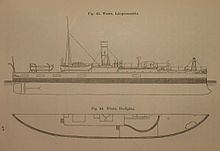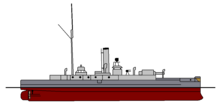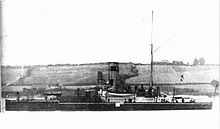Wasp class
|
The adder
|
||||||||||||||||
|
||||||||||||||||
|
||||||||||||||||
|
||||||||||||||||
|
||||||||||||||||
The Wespe- class was a class of eleven armored cannon boats of the Imperial Navy . The boats were designed for the defense of the German tidal flats and estuaries in the German Bight and built between 1875 and 1881 by AG Weser in Bremen . From 1877 to 1900, the units of the class were repeatedly used to train the teams. Overall, however, the boats were rarely in service and were mostly in reserve. After being deleted from the list of warships by 1911, almost all units were used for a few years, the Viper as a floating crane even until the 1960s.
history
Development and construction
The experience gained during the Crimean War led to the development of deep-sea armored ships and smaller armored gunboats around the world . After Helmuth von Moltke was appointed Chief of Staff in 1858, plans were made under his leadership to defend the Prussian North and Baltic Sea coasts, including "armored sea gunboats". On the part of the German Confederation , such considerations were made, including the non-Prussian coastline, but the Prussian proposals were ultimately rejected. The plans for armored cannon boats were not ended, but continued in the following years. The assumed demand fluctuated between eight and eighteen units.
After the establishment of the German Empire , a fleet plan was drawn up in 1873 for the continuous development of the Imperial Navy, which had mainly emerged from the Prussian Navy. This also included seven armored cannon boats for the defense of the great estuaries in the German Bight. For reasons of cost, people wanted to avoid the difficult construction of coastal fortifications in these areas . Instead, the gunboats were supposed to function as floating mounts. Relatively small and flat-moving vehicles were planned, which should offer the enemy a low target and should also be able to dry out in the Wadden Sea if necessary .
According to these specifications, the construction plans for the armored cannon boats were drawn up in 1875, representing a new type of ship for the German Navy. Bremer Werft AG Weser, which had previously only built the two river monitors Rhine and Moselle for the Imperial Navy, was commissioned to build the boats . Between 1875 and 1882, eleven armored cannon boats were built in Bremen, although the demand was still estimated at thirteen in 1879. The armor material was ordered from Dillinger Hütte , which was only able to provide it in the required quality from 1878. The first five boats therefore had to be fitted with armor plates imported from Great Britain . The construction costs for the armored cannon boats each amounted to around 1.1 million marks and thus around a seventh of an armored ship of the Sachsen class built at the same time .
The Wasp- class suffered from the inexperience of the shipyard in warship building as well as the naval design bureau with this type of ship. Added to this were the uncertainties that existed in other navies with regard to the development of armored ship construction, both technically and tactically. The boats therefore had major defects which led to a negative assessment. The sea properties were poor, the steam route too short and the crew accommodations, even for the conditions at the time, very limited. The names of the ships gave the boats in the navy the collective term "insect squadron", the shortcomings in connection with the intended area of operation also led to the nicknames "Schlickrutscher" and "Wattbanzen". Regardless of this, the draft also attracted attention abroad and was discussed in the British specialist press.
Use and whereabouts
The use of the armored cannon boats began with the commissioning of the Wasp on November 26, 1876 to carry out the test drives. However, the boats were not used regularly until after 1880, when several units, but never more than five, were used every year in summer and autumn to train the crews and sometimes also for the autumn maneuvers of the fleet. A planned use of several boats in the Mediterranean during the British intervention in Egypt in the summer of 1882 was not realized. In that year only the bumblebee and in 1883 the salamander were in active use. From 1885 to 1891, every year in August and September, a training association was formed from viper and mosquito , both of which had not previously been commissioned, as well as salamanders . The wasp was the fourth boat to belong to the association in 1885 and the Camaeleon from 1886 . While three of the armored cannon boats were decommissioned after the exercises were completed, the Mücke remained active as the parent ship of the North Sea Reserve Division even during the winter.
In 1892 and 1893, none of the boats were used. Instead, minor modifications were made. So the boats received an armored command post and four additional smaller guns. From 1894 onwards, the Natter was put into service every summer, while the Crocodill was in service all year round in 1894/95 , the Mücke from 1895 to 1898 and the Scorpion from 1898 to 1900 . In 1897 and for the last time in 1900, all four boats were used for exercises in the association. With their decommissioning on September 24, 1900, the use of the Wasp class ended. With the exception of the mosquito , the boats had rarely been used. The bee had the shortest period of service with only 81 days of work in 1881 and 1884. The basilisk, on the other hand, was in use for 125 days in 1880 and 1881 for 29 years until it was deleted, without being used again.
Between 1909 and 1911, all wasp-class units were removed from the list of warships. Then they were used for a number of years for various purposes, for leak tests, as a floating workshop or as a boat , in the navy or by private buyers. The Salamander was to be transferred to Düsseldorf for a purchase price of 52,000 marks . In November 1910, however, it ran aground west of Castricum and had to be abandoned. The superstructure was scrapped in 1936. The rest of the wreck silted up. The Hummel came to Swinoujscie as a depot ship , where it was sunk by aerial bombs on May 4, 1945 as the 194th flak ship, making it the second boat in the class to be lost. The Viper , the last boat of the Wasp class converted into a crane ship , was still in existence in 1962.
Boats of the class
- Wasp : Launched on July 6, 1876. The first commissioning took place on November 26, 1876, followed by short deployments in the spring of 1877 and in the autumn of 1880, 1881 and 1885. On June 28, 1909, deleted from the list of warships, to Düsseldorf sold and used up there as a cream.
- Viper : launched on September 21, 1876. The boat was first put into service on August 20, 1885. In 1886 a deployment followed in May and June. The boat was activated in August and September for the following five years. Removed from the list of warships on June 28, 1909, it was later converted into a crane ship. As such, it was instrumental in the salvage of the large- scale ship SMS Rheinland in1918and was used at least until 1962 off Helgoland and in Wilhelmshaven .
- Bee : Launched on December 2, 1876. The first commissioning on August 20, 1881 was only followed by a further period of use from April to June 1884. After being removed from the list of warships on September 27, 1910, the boat was used as a workshop ship and in 1921 in Wewelsfleth wrecked.
- Mücke : Launched on May 5th, 1877. The first commissioning took place on May 1st, 1885. The boat was kept in service until 1891 and from 1895 to 1898. A last use took place in the summer of 1900. On March 18, 1911, the Mücke was removed from the list of warships and converted into a heating ship, sold in 1921 and broken up in Wewelsfleth.
- Scorpion : launched on May 19, 1877. First commissioned on September 5, 1884, the boat was used in 1895, 1897 and 1898 to 1900. Removed from the list of warships on March 18, 1911, the Scorpion was used at the torpedo workshop in Flensburg until 1918, sold in 1919 and initially used as a scrapping workshop before the boat itself was demolished in 1924.
- Basilisk : Launched on September 14, 1878. After the first commissioning on August 20, 1880, the boat was used with a short interruption until November 1880 and a second and last time in August and September 1881 and then laid up . On September 27, 1910, the basilisk was removed from the list of warships and assigned to the leak test command, sold in 1919 and scrapped in Hamburg in 1920.
- Camaeleon : launched on December 21, 1878. The boat was first put into service on August 20, 1880 for the test drives. In the years 1881, 1884 and from 1886 to 1891 further assignments took place in the summer. Removed from the list of warships on June 28, 1909, the boat was sold in 1910 and used up as a ship.
- Crocodill : launched on September 13, 1879. The first commissioning took place on September 20, 1880. The boat was used again in 1884, 1894/95, 1897 and 1900. After being deleted from the list of warships on March 18, 1911, the Crocodill was used as a target ship and from 1913 as a floating workshop. After 1918 the boat was scrapped.
- Salamander : launched on January 6, 1880. First put into service on September 4, 1883, the boat was used annually in the summer between 1885 and 1891. The deletion from the list of warships took place on June 28, 1909. In 1910 the Salamander was sold to Düsseldorf for scrapping, but stranded on the overpass in front of Castricum.
- Natter : Launched on September 29, 1880. The first commissioning took place on June 15, 1884. From 1894 to 1900 the boat was used in summer. Removed from the list of warships on March 18, 1911, the Natter was used as a floating power plant in Wilhelmshavenunder the name Stromquelle I until 1924, then in Kiel until at least 1928. Later, under the old name, it was used as a heating cream. In 1946 the boat was finallyscrappedin Mönkeberg .
- Hummel : Launched on February 12, 1881. The first commissioning on May 22, 1882 was only followed by a second deployment in the summer of 1884. On September 27, 1910, the boat was deleted from the list of warships. Until the end of the First World War , the boat was usedas a workshop ship, used as a depot ship from 1923. During the Second World War , the Hummel was used as a flak ship and as such was sunk in Swinoujscie on May 4, 1945.
technology
The Wespe- class boats, which were made as cross- rib iron structures, displaced a maximum of 1163 t , whereby the structural displacement was calculated at 1098 t. The boats were a total of 46.4 m long, with the construction waterline measuring 45.5 m, and 10.6 m wide. The maximum draft was 3.24 m forward and 3.4 m aft , although there were slight deviations in the individual boats. The hull was divided into ten watertight compartments to increase the safety against sinking . A little more than half of the flat floor required for drying out was constructed as a double floor.
Originally the boats did not have any electrical equipment. However, this was added later in 1892/93. The power supply was provided by a generator that generated a maximum output of 1.9 kW at a voltage of 55 V.
The Wasp- class units were poor ocean-going vessels. They were very eager to luff and had a pronounced tendency to roll, which prevented them from shooting at wind force 4 to 5. In addition, the boats were very wet and took over a lot of water even when the sea was rough . Due to the high torque, the armored cannon boats were difficult to steer and the rotation, once initiated, was difficult to stop.
Propulsion system
The machine system of the armored cannon boats consisted of two inclined two-cylinder composite steam engines , which were housed in a common boiler room. The constructive performance of 700 PSi was in some cases significantly exceeded on all boats, so the engine system of the Hummel achieved 756 PSi, that of the Wasp even 800 PSi. Each of the steam engines acted on a four- bladed propeller with a diameter of 4.2 m.
Four cylinder boilers were located in a common boiler room for the steam supply . These were installed lengthways in the wasps and vipers and transversely from the bees onwards and generated a vapor pressure of 4 atmospheres . The boilers had eight firings and a total heating surface of 294 m².
The propulsion system enabled the boats to reach a maximum speed of 10.4 kn ( Wasp ) to 11.2 kn ( Crocodill ). This means that all units in the class considerably exceeded the required maximum speed of 9 knots. The fuel supply of 40 t of coal carried with them enabled the boats to travel 700 nm at a cruising speed of 7 knots.
Armament
The main armament was a 30.50 cm L / 22 ring cannon on board, which was set up in an open, semicircular barbette on the forecastle. With a maximum barrel elevation of 20 °, the cannon reached a range of 10 km. Until 1883 this gun, for which 38 rounds of ammunition were carried, was the only armament of the boats apart from the ram . In 1892/93 the Barbette was given an additional parapet, which was supposed to protect the gun not from enemy fire, but from the swell and overflowing water. Below the waterline , but still above the ram, two torpedo tubes with a diameter of 35 cm were installed next to each other in 1883 . There was only one torpedo on board for each tube . In the course of the minor modification, the armament was expanded to include two 8.7 cm L / 24 ring cannons on both sides of the stern, each with a supply of 100 rounds of ammunition. In addition, two came 3.7cm - revolver cannon on board.
Armor
Wrought iron plates attached to a teak base were used as armor material . Equipment with the emerging compound armor made of iron and steel was dispensed with, although it was significantly more resistant. The belt armor extended the entire length of the boat and reached from about 75 cm below the waterline to the upper deck. It consisted of 102 to 203 mm thick iron plates with a 210 mm thick wooden base. The Barbette received 203 mm armor throughout, which was also applied to 210 mm wood. The armored deck , which had no embankments, consisted of two layers, 22 and 28 mm thick. The command tower added in 1892/93 was provided with 20 mm thick armor.
crew
The crew consisted of three naval officers , four deck officers and 81 non-commissioned officers and men . When the divisional headquarters were embarked, three officers and five to eight other seamen were on board.
literature
- Gröner, Erich / Dieter Jung / Martin Maass: The German warships 1815-1945 . tape 1 : Armored ships, ships of the line, battleships, aircraft carriers, cruisers, gunboats . Bernard & Graefe Verlag, Munich 1982, ISBN 3-7637-4800-8 , p. 164 f .
- Hildebrand, Hans H. / Albert Röhr / Hans-Otto Steinmetz: The German warships . Biographies - a mirror of naval history from 1815 to the present . 10 volumes. Mundus Verlag, Ratingen.
- Weyer, B. (Ed.): Pocket book of the German war fleet . JF Lehmanns Verlag, Munich 1900, p. 23 .
Web links
Footnotes
- ↑ a b c d e f Hildebrand / Röhr / Steinmetz: The German warships. Volume 8, pp. 69f.
- ↑ a b Hildebrand / Röhr / Steinmetz, Volume 2, p. 40 f.
- ↑ a b c d e f g h i j Gröner, Erich: The German warships. Volume 1, p. 64 f.
- ↑ Corresponds to around € 8,410,000 today.
- ↑ Gröner, Volume 1, p. 32.
- ↑ H. Merleker: Ships also have nicknames in Die Seekiste No. 2 1951, p. 82/83
- ↑ Hildebrand / Röhr / Steinmetz, Volume 8, p. 48.
- ↑ Hildebrand / Röhr / Steinmetz, Volume 2, p. 63 f.
- ↑ Hildebrand / Röhr / Steinmetz, Volume 6, p. 121 f.
- ↑ Hildebrand / Röhr / Steinmetz, Volume 7, p. 150.
- ↑ Hildebrand / Röhr / Steinmetz, Volume 2, p. 167 f.
- ↑ Hildebrand / Röhr / Steinmetz, Volume 2, p. 198.
- ↑ Hildebrand / Röhr / Steinmetz, Volume 7, p. 102.
- ↑ Hildebrand / Röhr / Steinmetz, Volume 6, p. 140 f.
- ↑ Hildebrand / Röhr / Steinmetz, Volume 4, p. 182.





